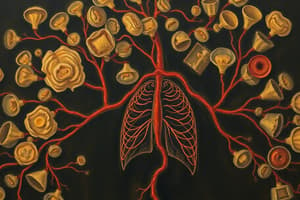Podcast
Questions and Answers
What is the primary function of the myelin sheath in the nervous system?
What is the primary function of the myelin sheath in the nervous system?
- To provide insulation for axons (correct)
- To enhance muscle contraction
- To facilitate synaptic cleft formation
- To transmit neurotransmitters efficiently
Which neurotransmitter is primarily associated with excitatory functions in the autonomic nervous system?
Which neurotransmitter is primarily associated with excitatory functions in the autonomic nervous system?
- Dopamine
- Acetylcholine
- Serotonin
- Norepinephrine (correct)
What happens at the Nodes of Ranvier during an action potential?
What happens at the Nodes of Ranvier during an action potential?
- Neurotransmitter release happens
- Neuronal electrical insulation is decreased
- Myelination increases
- Ion exchange occurs, leading to action potential propagation (correct)
How does dopamine contribute to the effects seen in Parkinson's disease?
How does dopamine contribute to the effects seen in Parkinson's disease?
Which neurotransmitter is directly linked to muscle rigidity and slowness of movement in Parkinson’s disease?
Which neurotransmitter is directly linked to muscle rigidity and slowness of movement in Parkinson’s disease?
What characterizes metabotropic receptors in chemical synapses?
What characterizes metabotropic receptors in chemical synapses?
Which of the following symptoms is NOT typically associated with Parkinson's disease?
Which of the following symptoms is NOT typically associated with Parkinson's disease?
Which biogenic amine neurotransmitter can have both excitatory and inhibitory effects depending on the brain region?
Which biogenic amine neurotransmitter can have both excitatory and inhibitory effects depending on the brain region?
What effect does wider axon diameter have on action potential conduction?
What effect does wider axon diameter have on action potential conduction?
What characterizes excitatory postsynaptic potential (EPSP)?
What characterizes excitatory postsynaptic potential (EPSP)?
What is the primary role of neurotransmitters in chemical synapses?
What is the primary role of neurotransmitters in chemical synapses?
How do neuromuscular conditions like myotonia impact muscle function?
How do neuromuscular conditions like myotonia impact muscle function?
What initiates the action potential in a neuron?
What initiates the action potential in a neuron?
What is the outcome of neurotransmitter binding to the postsynaptic membrane?
What is the outcome of neurotransmitter binding to the postsynaptic membrane?
What is the relationship between action potential frequency and signal strength?
What is the relationship between action potential frequency and signal strength?
What is the role of the axon hillock in the neuron?
What is the role of the axon hillock in the neuron?
What role do microglia serve in the nervous system?
What role do microglia serve in the nervous system?
What occurs when a graded potential reaches the threshold potential of approximately -55mV?
What occurs when a graded potential reaches the threshold potential of approximately -55mV?
Which type of ion channels respond to a change in membrane potential?
Which type of ion channels respond to a change in membrane potential?
What is the primary mechanism by which neurotransmitters act at chemical synapses?
What is the primary mechanism by which neurotransmitters act at chemical synapses?
What causes hyperpolarization in a neuron?
What causes hyperpolarization in a neuron?
Which neurotransmitter is primarily associated with muscle contraction?
Which neurotransmitter is primarily associated with muscle contraction?
What is saltatory conduction?
What is saltatory conduction?
How do electrical synapses differ from chemical synapses?
How do electrical synapses differ from chemical synapses?
Flashcards
Myelin sheath
Myelin sheath
Insulation covering axons, produced by oligodendrocytes (CNS) and Schwann cells (PNS).
Nodes of Ranvier
Nodes of Ranvier
Gaps in the myelin sheath, where action potentials occur.
Synaptic cleft
Synaptic cleft
The small gap between neurons where transmission occurs.
Neurotransmitters
Neurotransmitters
Signup and view all the flashcards
Biogenic amines
Biogenic amines
Signup and view all the flashcards
Parkinson's Disease
Parkinson's Disease
Signup and view all the flashcards
Dopamine
Dopamine
Signup and view all the flashcards
Schizophrenia
Schizophrenia
Signup and view all the flashcards
Action Potential
Action Potential
Signup and view all the flashcards
Depolarization
Depolarization
Signup and view all the flashcards
Synaptic Transmission
Synaptic Transmission
Signup and view all the flashcards
Synaptic Vesicles
Synaptic Vesicles
Signup and view all the flashcards
EPSP (Excitatory Postsynaptic Potential)
EPSP (Excitatory Postsynaptic Potential)
Signup and view all the flashcards
IPSP (Inhibitory Postsynaptic Potential)
IPSP (Inhibitory Postsynaptic Potential)
Signup and view all the flashcards
Summation
Summation
Signup and view all the flashcards
Chemically-gated ion channels
Chemically-gated ion channels
Signup and view all the flashcards
Voltage-gated ion channels
Voltage-gated ion channels
Signup and view all the flashcards
Graded potential
Graded potential
Signup and view all the flashcards
Hyperpolarization
Hyperpolarization
Signup and view all the flashcards
Electrical synapse
Electrical synapse
Signup and view all the flashcards
Chemical synapse
Chemical synapse
Signup and view all the flashcards
Study Notes
Circulation and Gas Exchange
- Circulatory systems link exchange surfaces with cells throughout the body
- Unicellular organisms exchange materials through diffusion
- Simple body plans, like flatworms, maximize surface area and minimize diffusion distances
- Circulatory systems are adaptations that enable efficient transport of substances over larger distances
Gastrovascular Cavities
- Found in certain invertebrates (hydras, cnidarians, flatworms)
- These cavities serve as both digestive and circulatory systems
- Many animals can survive without a circulatory system
Circulatory Systems
- Open circulatory systems
- Hemolymph (circulatory fluid) is also interstitial fluid
- Hemolymph is pumped to interconnected sinuses (spaces)
- Less energy efficient (lower hydrostatic pressure)
- Found in arthropods (e.g., grasshoppers, crabs) and some mollusks
- Closed circulatory systems
- Blood is the circulatory fluid, distinct from interstitial fluid
- Blood is efficiently transported through interconnected vessels
- Found in annelids (earthworms), cephalopods (e.g., squids, octopuses), and vertebrates
- Cardiovascular system
- Contains arteries, arterioles, capillaries, venules, and veins
- Arteries carry blood away from the heart
- Veins carry blood back to the heart
- Capillaries are networks of tiny blood vessels
- Exception: portal veins carry blood between capillary beds
Single Circulation
- Blood flows through the body in a single loop, returning to the heart
- Two-chambered hearts are seen in sharks, rays, and bony fishes
Double Circulation
- Two circuits (pulmonary and systemic) are seen in amphibians, reptiles, and mammals
- Pulmonary circuit: right side of the heart pumps oxygen-poor blood to the lungs for gas exchange
- Systemic circuit: left side of the heart pumps oxygen-rich blood to the rest of the body
- Higher blood pressure in systemic circulation, better for gas exchange
Additional Notes
- Amphibians may use their skin for gas exchange
Studying That Suits You
Use AI to generate personalized quizzes and flashcards to suit your learning preferences.





